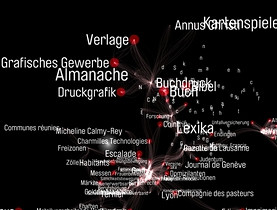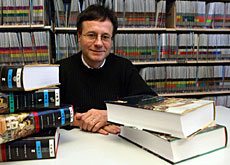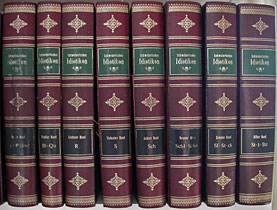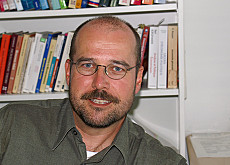Making sense of history

Switzerland is a small country, but being home to four different language groups and cultures it has a complicated history.
To compile an encyclopedia of this history represents an immense challenge; the first attempts to tackle it date back to the 17th century, and the latest is currently underway.
The Historical Dictionary of Switzerland foundation was set up in 1988, and is now just past the midway point in its mammoth task of producing a 13 volume reference work.
But in Switzerland, 13 means 39: the Historical Dictionary – abbreviated to HLS in German – is coming out in German, French and Italian. And there’s an abbreviated version in the country’s fourth language, Romansh, as well.
A modest exhibition currently on show in the Swiss National Library in Bern, entitled “In the Beginning is the Word”, gives the public an insight into what producing such an encyclopedia means.
It illustrates the process through the example of Ruth Dreifuss, interior minister – thus responsible for culture and ultimately for the HLS itself – when work started on the dictionary. She gave it her strong backing at an important time, and features in it herself.
Daunting task
What does an entry entail? It has to be commissioned, and written, checked, corrected, and translated; it’s full of cross-references to other entries. At the same time, it has to be as factual as possible – and that means that lots of things have to be left out too.
The cross-references in the Dreifuss article fill in some of the background: the history of the Jews in Switzerland (Dreifuss is Jewish), the feminist movement (in which she played an important part), the social security system (which she fought for), Geneva (her home town)…
But the exhibition also tantalisingly displays some of the things that can’t go in: pictures and memorabilia, for example, that would flesh out the real person.
In a video interview included in the exhibition Dreifuss comments that she only half recognises herself in her entry – “but that’s probably the same for everyone”.
“It’s hard to resume 68 years in 30 lines,” she admits.
The editing has to be rigorous. On display are letters and draft entries sent backwards and forwards between contributors and consultants; a checklist contains the commonest problems: “too long”, “too short”, “doesn’t reflect the latest research”, “not enough relevance to Switzerland”, “lacks balance in reference to language/region/confession/period/gender”.
Translation
The fact that the HLS is coming out in three languages makes the task even more daunting.
The first thing that had to be done was to draw up the list of headwords. The problem is that concepts often begin with a different letter depending on the language. The favourite example is Arsenal: it begins with “A” in French and Italian, but the German is Zeughaus.
Obviously a name like Dreifuss doesn’t change from one language to another – but you can’t take even that for granted, Marco Jorio, the editor in chief, told swissinfo. “The German name Ligerz is Gléresse in French, for instance. And Charlemagne is Karl der Grosse in German.”
“So it took quite a long time to get going, because we could only begin once the list of headwords was complete. We couldn’t start production and then think: ‘Oh, we could have had another article in the first French volume, we’ll have it just in the seventh German one.'”
The editors also had to choose a cut-off point: no-one born after 1935 gets an entry – except for members of the government and Nobel prize winners. But even that posed a problem: Christoph Blocher was elected to the cabinet after “B” had been published…
Then there was the problem of translation. The authors had to be warned to write in a “translation-friendly” style. No complicated constructions, and all technical expressions to be explained.
“At first we didn’t know whether to use professional translators, who don’t know anything about history, or historians who don’t know much about translating. We did tests, and found that it is simpler to make historians into translators than the other way round,” said Jorio.
But the need to translate does have benefits too, since it acts as an extra check, picking up things that are not clear, or even the occasional mistake.
It all takes a lot of time. For the articles the commissioning editors normally approach acknowledged experts in the particular field; the process takes on average 12 to 18 months from commissioning to print. Then the HLS is also lavishly illustrated, not only with pictures but also with graphics produced especially for it.
Future plans
The books are beautiful, but – inevitably – they are not cheap. And yet anyone can have free access to the contents, since the text is also available on the internet. Not the pictures however, for copyright reasons. And not the graphics, although they may yet come, since they were created by the HLS itself.
Once the last printed volume is out in 2014, Jorio hopes to be able to continue work on the database and expand the web version. But the future depends on the finances – it currently receives SFr5.5 million ($4.5 million) per year from the state.
“I’m still hoping we’ll get the money for an English edition – a partial one, like the one in Romansh, and only online,” he said.
Anyone who has an interest in Switzerland should keep their fingers crossed!
swissinfo, Julia Slater
The HLS foundation, responsible for the dictionary, was founded in 1988.
It was backed by the Swiss History Society and the Swiss Academy of Humanities and Social Sciences.
The HLS, in identical German, French and Italian versions, will have 13 volumes in all. They appear at the rate of one a year.
Volume 8 has gone to print, and work is underway on Volume 9. Volume 13 is scheduled to appear in 2014.
The text of the HLS is also published on line as the articles are written. A shorter version in Romansh is also available on line. It is hoped to produce an online version in English in the future.
The HLS is financed by the Swiss government at SFr5.5 million per year.
Each volume – containing about 3,000 articles – costs SFr298.
The predecessors of the HLS include:
The 20-volume “Allgemeines helvetisches, eydgenössisches oder schweitzerisches Lexikon” of Johann Jakob Leu, 1786-95
The 58-volume Encyclopédie d’Yverdon, 1770-80
The 8-volume Historical and Biographical Dictionary of Switzerland, 1921-34

In compliance with the JTI standards
More: SWI swissinfo.ch certified by the Journalism Trust Initiative



You can find an overview of ongoing debates with our journalists here. Please join us!
If you want to start a conversation about a topic raised in this article or want to report factual errors, email us at english@swissinfo.ch.